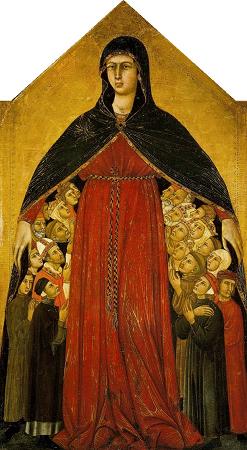Madonna. A Madonna is a representation of the Virgin Mary. She is frequently shown holding the infant Jesus, emphasizing the maternal bond between mother and son. Often, Mary is depicted seated on a throne, usually with the infant Jesus on her lap. She appears as a regal figure, sometimes adorned with a crown or other symbols of royalty, highlighting her status as the Queen of Heaven and Earth. The Annunciation depicts the moment when the angel Gabriel announces to Mary that she will bear the Son of God. Often Mary is shown in prayer, with the Holy Spirit represented as a dove descending upon her. Sometimes she is depicted holding a rosary, emphasizing her role as a mediator between humanity and God. In Madonna of Mercy, she is shown with outstretched arms, sheltering and protecting a group of people beneath her cloak. The Madonna Dolorosa or Sorrowful Mother theme depicts Mary in a state of sorrow or mourning, often with tears streaming down her face, as she contemplates the suffering and death of her son, Jesus. Paintings of Madonna with Saints emphasize Mary's role as a central figure in the communion of saints and highlights her intercessory power and spiritual significance within the Christian tradition. These images are central icons for both the Catholic and Orthodox churches. Madonna may be generally used of representations of Mary, with or without the infant Jesus, is the focus and central figure of the image, possibly flanked or surrounded by angels or saints. Other types of Marian imagery have a narrative context, depicting scenes from the Life of the Virgin, e.g. the Annunciation to Mary, are not typically called Madonna. The earliest depictions of Mary date still to Early Christianity, found in the Catacombs of Rome. These are in a narrative context. The classical Madonna or Theotokos imagery develops from the 5th century, as Marian devotion rose to great importance after the Council of Ephesus formally affirmed her status as Mother of God or Theotokos in 431. The Theotokos iconography as it developed in the 6th to 8th century rose to great importance in the high medieval period both in the Eastern Orthodox and in the Latin spheres. According to a tradition recorded in the 8th century, Marian iconography goes back to a portrait drawn from life by Luke the Evangelist, with a number of icons claimed to either represent this original icon or to be a direct copy of it. In the Western tradition, depictions of the Madonna were greatly diversified by Renaissance masters such as Duccio, Leonardo da Vinci, Michelangelo, Raphael, Giovanni Bellini, Caravaggio, and Rubens, while Eastern Orthodox iconography adheres more closely to the inherited traditional types.
more...














